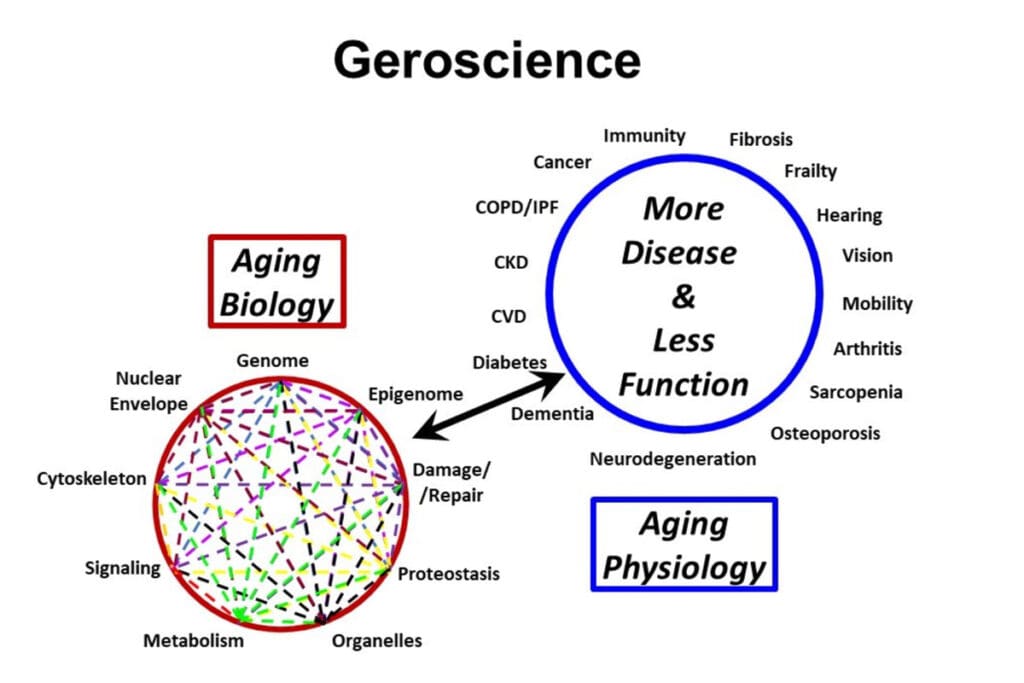
Geroscientists are pursuing potential drugs that could expand the “healthy” years of one’s life span. Researchers are also testing whether these drugs might slow the aging process.
The Downside of Living Longer
In the early 1800s, the average human lifespan was only about 30 years. But the advent of modern medicine changed all that. Human lifespan has more than doubled today.
Even in 1950, the average global life expectancy was only 45.51 years, according to projections by the United Nations, Macrotrends reported. The average lifespan in 2024 is estimated at 73.33. By 2050, the average lifespan is expected to rise to 77 years.
There’s a double-edged sword to living longer. While a longer life can be a wonderful experience if you’re healthy, there’s a major downside if you’re not. If you’re dealing with a chronic illness or disease, living longer means you might suffer with that condition longer.
Conditions that come with aging rob people of their quality of life. Recognizing this, scientists are looking for solutions.
The Burgeoning Field of “Geroscience”


Geroscience is a field of study at the intersection of aging biology, chronic disease, and health, according to the National Institute on Aging, part of the National Institutes of Health (NIH).
Statistically, as people age, they are more likely to be diagnosed with one or more chronic ailments. Some of these are life-threatening including cardiovascular disease, stroke, diabetes, and cancer. There are also a variety of debilitating conditions such as arthritis, osteoporosis, hypertension, respiratory diseases, Alzheimer’s, and related dementias. Aging can also lead to fatigue and frailty.
Geroscience focuses on seeking to understand the genetic, molecular, and cellular mechanisms that make aging a major risk factor and driver of common chronic conditions and diseases of older people.
An NIH-wide initiative has been directed at the study of aging and now encompasses involvement by 21 of the organization’s institutes and centers.
In summary, the goal of geroscientists is to discover and address the root causes of aging. Armed with this understanding, they hope to develop methods of staving off the diseases and disability that can make old age so miserable.
Scientists Are Developing Drugs to Keep People Healthier for Longer
The concept that geroscientists are working on is to compress the years of illness that often accompany old age into a shorter timeframe. The idea is to help people live and feel healthier for a longer time than they do now.
One approach is to develop medications that slow the development of conditions and diseases that have debilitating effects. Such medications might be taken daily for years, much like a supplement.
“Let’s build a medicine that would be safe enough for someone in midlife to take almost like a supplement, like a daily vitamin, but with much more profound biological effects,” said James Peyer, CEO of Cambrian Bio, in an interview with Science News.
However, scientists also want to make sure that people understand the development of potential medications to slow down the development of diseases aren’t anti-aging drugs. The market of anti-aging therapies ranges from supplements to face creams and more.
“That term is associated with an industry that is trying to sell products to the public to separate people from their money,” said S. Jay Olshansky, a geroscientist and demographer at the University of Illinois Chicago. “It’s bogus,” he says of anti-aging products.
By contrast, geroscientists around the world at respected institutions are engaged in legitimate research to discover and develop medications that can slow the aging process. Some of these compounds are under study and in clinical trials. Already, some show promise in mice and humans.
Finding Compounds That Fight Aging
As yet, there are no proven therapies that slow the aging process. However, geroscientists are investigating several promising prospects. These are being tested in fruit flies, worms, and mice. A few have been tested in humans. Numerous clinical trials are underway.
An Effective Compound Found in Easter Island
One of the best studied thus far is rapamycin, also known as Sirolimus. The compound was first discovered in a soil sample collected in 1964 from Rapa Nui, or Easter Island. It is produced by the bacterium Streptomyces hygroscopicus and was isolated for the first time in 1972.
It is currently sold under the brand name Rapamune among others. Its current usage includes coating coronary stents, preventing organ transplant rejection, treating a rare lung disease called lymphangioleiomyomatosis, and treating perivascular epithelioid cell tumors (PEComa). It is also used in the cardiovascular drug-eluting stent technologies to inhibit restenosis.
In the field of geroscience, researchers have found that rapamycin prolongs life in yeast, flies, and mice. It is now undergoing clinical trials with humans. Although rapamycin is showing effectiveness, how it counters the aging process isn’t clear. However, it is known that the drug inhibits a protein complex called the mechanistic target of rapamycin (mTOR).
Fewer Infections and Better Response to Vaccines
Other drugs are being developed that also impact mTOR. Researchers are testing other mTOR inhibitors in elderly adults to try and improve immune function. Human trials have found that the drugs they tested resulted in fewer infections in people and a better response to the flu vaccine. In a subsequent study, however, the drug failed to show an effect on self-reported respiratory illnesses. The company continues to work on developing new rapamycin analogs, or “rapalogs.”
Promising: Senolytics
In other research, scientists are working on a group of drugs called senolytics. Senescent cells are cells that have stopped dividing and doing their jobs, but will not die. Worse, senescent cells hang around and pump out inflammatory chemicals that may damage surrounding tissues and promote further aging.
“They’re zombie cells,” said Steven Austad, a biogerontologist at the University of Alabama at Birmingham. “They’ve outlived their usefulness. They’re bad.”
Suicidal Cells
Synolytic drugs would target senescent cells by prompting them to “commit suicide.” Essentially, senolytics work by killing and removing worn-out cells.
The strategy for making the senescent cells eliminate themselves by “committing suicide” was developed by cancer biologist Jan van Deursen of the Mayo Clinic in Rochester, Minnesota, and colleagues.
The research team hooked up a gene for a protein that causes cells to kill themselves to DNA that helps turn on the production of a protein called p16 that builds up in senescent cells. Therefore, whenever p16 was made the suicide protein was also made.
Numerous Trials Underway
Senolytics are now being tested in humans. There are more than 25 clinical trials underway or that have been completed.
Studies in mice found that these drugs helped middle-aged mice live longer and healthier lives. The lifespans of the middle-aged mice were increased from 24 to 27 percent.
Research by the Mayo Clinic published in the journal Nature found that senescent cells also improved heart and kidney function.
However, some senescent cells were easier to kill in some organs than others. For example, the treatment worked in organs such as the eyes, fat, heart, and kidneys. The treatment worked on age-related declines in the function of these organs. However, senescent cells were not killed in the liver or colon. Nonetheless, what did work was extremely promising.
“If this paper is right, I believe it will be one of the most important aging papers ever,” according to gerontology and cancer researcher Norman Sharpless of the University of North Carolina School of Medicine in Chapel Hill.
Researchers hold high hopes for senolytics. They hypothesize that periodically removing senescent cells by use of a drug could lead to an entirely new way to treat aging. Such drugs might be able to temporarily turn back the clock and improve health for people who are already aging.
Still, as promising as the ability to eliminate senescent cells and slow aging is, researchers also understand that aging is a complex process.
“We don’t believe senescence is the only thing that drives aging,” said Judith Campisi, a researcher at the Buck Institute for Research on Aging in Novato, California. “That would be stupid. If this were the magic bullet, [the] mice would live forever, but they don’t.”
Read More: These Scientists are Attempting to Regrow Teeth
Developing Drugs for Healthy Old Age Is More Important than Ever
Although people are living longer these days and are expected to continue to do so, they are not necessarily living healthier. Despite advances in medicine, people today are not necessarily living healthier than previous generations either.
One important reason to develop medications that lead to better health in old age is that the population of older people is about to grow substantially. In the United States, by 2030, 73 million baby boomers in the United States will be 65 or older. Globally, experts estimate that around 1 billion people will be aged 65 and over. Worse, that figure could reach 2.5 billion globally by the end of the century.
This situation presents a problem on many fronts, one of which is the ability of global healthcare systems and infrastructure to meet the challenge of such a large population of older people suffering from health conditions.
“There’s this fear of what is this going to do to our health care system,” said Laura Niedernhofer, a geneticist and researcher studying aging at the University of Minnesota in Minneapolis. “And it goes well beyond just health care. We don’t have the nursing homes. We don’t have the personal care staff to deal with this at all.”
However, if scientists can develop drugs that will keep older adults healthier it may stave off a looming crisis. Older adults who are active and independent become a boon to society rather than a liability.
Read More: Want to Keep Your Youthful Skin? Read This Now.
Milestones in Geroscience
When people only lived to age 30 on average in the 1800s, or even 45 on average by 1950, there was not such a large pool of people living into old age. But by now, people are living long enough that doctors and scientists are observing the frailty and illness that accompanies old age.
Science now understands a lot of the mechanics involved in human aging. Cells stop dividing and die. The immune system falters. DNA degrades, and much more. Aging humans become increasingly vulnerable to disease. In the last decades of life, many people will suffer from numerous illnesses and diseases.
Unfortunately, doctors treating people in old age put most of their efforts into trying to combat a variety of illnesses that pop up one after another. Doctors mostly try to keep the severity of symptoms at bay.
Until now, many scientists believed the gradual decline that accompanies old age was unavoidable. However, findings from experiments in the 1980s and 1990s suggested the process of aging may not be as fixed as previously thought.
In one of the first notable experiments to demonstrate success at slowing the effects of aging, scientists identified mutations in a single gene in the roundworm C. elegans. This mutation allowed C. elegans to live twice as long as the wild type. It was the largest lifespan extension reported in any organism at the time (1993).
This finding and other similar ones led scientists to postulate that the aging process is malleable. Therefore, scientists might be able to develop effective therapies that could affect the root mechanisms of aging. This holds the promise of being a more efficient therapy against aging, rather than combating a continual pileup of diseases.
Felipe Sierra, who was then a program officer at the National Institute on Aging in Bethesda, Maryland was seeking a name to better describe the developing field of research on aging. Aging biology had moved toward a phase of molecular investigation. Sierra chose Geroscience. He had first seen the word in a grant proposal by Gordon Lithgow, another researcher studying aging. “Gero” comes from the Greek word for “old man.”
Read More: How A Blood Test May Reveal Your Chances to Live to 100
The Outlook and Challenges Ahead
The question geroscientists are facing is whether or not it will be possible to develop such drugs. It is a challenge to bring such medications to market. Funding for research is always a major obstacle. Whether researchers and scientists can accomplish their objectives of keeping people healthier for a longer time remains to be seen.









